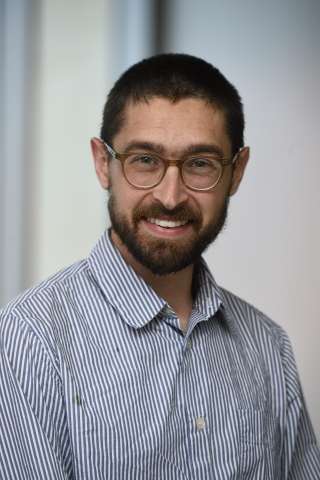
Boosting Public Health by Preserving the Past: Q&A with Bloomberg Fellow Eli Pousson
May 19, 2020
Eli Pousson rides a big orange cargo bike to carry his small kids to school, the library, and almost everywhere they need to be. Biking, he says, is just another way of caring for his neighbors and the neighborhoods where he lives and works. “Walking or biking most places means I'm never going too fast to see the city around me and spot all the opportunities to lend a hand, whether that means checking on a tired neighbor, picking up a pile of trash, or reporting a broken park bench,” Eli says. “In the face of a global climate crisis, everyone—from kids to seniors—should be able to walk and bike safely around the city so we can all make new friends, improve our health, and protect our shared environment.”
In his work with Baltimore Heritage, a small non-profit organization that works to preserve historic places and revitalize historic neighborhoods across the city, Eli has worked on projects that combine historic preservation, neighborhood revitalization, and inclusive community outreach. Past projects include promoting historic parks through the Friends of West Baltimore Squares, preparing landmark nominations to support the rehabilitation of unique at-risk buildings like the 1876 Hebrew Orphan Asylum, organizing archaeological digs in local parks, and creating the Explore Baltimore Heritage website and app.
We spoke with Eli about his passion for historic preservation and its connection with the health of neighborhood residents.
What drives you, and how did this bring you to your interest in public health?
I'm motivated by a sense of gratitude to the people who have tried to make Baltimore a better place in the past—and a sense of hope that there are plenty of Baltimoreans still working hard to secure justice, health, and happiness for themselves and their neighbors. Behind every worn-down building are real people who are dealing with the consequences of these challenges. My interest in public health grew out of my work at Baltimore Heritage and my curiosity about how the places all around us—whether they are doing well or falling apart—affect our shared health and well-being and what role old buildings can play in helping make Baltimore a healthier and happier place.
What public-health related work have you done that you’re most proud of?
One project that made a big difference in my own perspective on Baltimore Heritage’s work is our collaboration with the Community Law Center to organize a series of workshops called Vacant Buildings 101. Together with Becky Witt, one of the Center's attorneys, I pulled together resources on how to report code violations, self-help nuisance abatement, receivership, housing market typologies, and the emerging research on the health effects of vacant buildings. The workshops sparked dozens of conversations with residents dealing with abandoned houses on their block and small builders trying to figure out how they could help fix up old houses.
What question or problem in your community keeps you up at night?
Vacant buildings and so-called “blighted” neighborhoods are often presented as the inevitable result of a declining population and post-industrial economy. But looking at the city's history shows the close connections between vacant houses, racial segregation, and sprawling regional growth that forces people to depend on cars to get everywhere. The more I learn about health, transportation, and housing in Baltimore, the more I worry. I worry about working neighbors who patiently endure hour-long bus rides but still can't afford to fix their leaky roof, landlords who evict poor families then dump their old mattresses on the closest vacant lot, and elected officials who respond to the global climate crisis by spending money on bigger highways instead of safer streets or better schools.
How is the Bloomberg Fellows Program helping you to tackle that problem? What impact do you hope you to make as a Bloomberg Fellow?
As a Bloomberg Fellow, I've been challenged to learn and reflect on how historic neighborhoods and public health connect. I've been especially excited to contribute my knowledge of Baltimore's buildings, neighborhoods, and history to collaborative research projects with JHSPH faculty. If we're going to deal with the challenge of vacant housing we all need a better understanding how abandonment, demolition, and vacant lots affect the health of city residents. To this end, I've been able to join ongoing studies on the effects of demolition under Project CORE with Dr. Craig Pollack and Dr. Cassandra Crifasi and on the effects of resident-led vacant lot stewardship by Dr. Kristin Mmari, Dr. Beth Marshall, and the city's Environmental Control Board (among many others). It has been satisfying to contribute my knowledge of these topics to a broader collaborative effort where we are all interested in applying public health research to improve the health of Baltimore residents.
Connect With Us
Receive all the latest news from the Initiative by signing up for the American Health Dispatch newsletter, subscribing to the American Health Podcast, and subscribing to our YouTube channel.
Contact Us